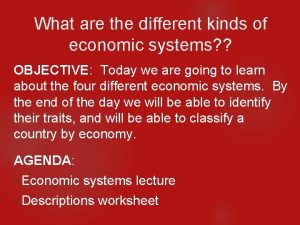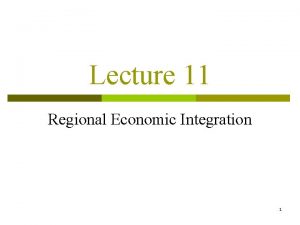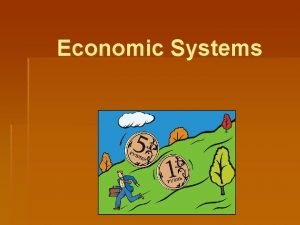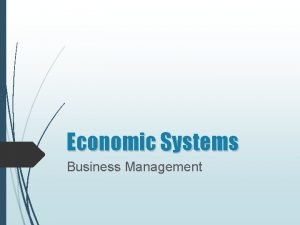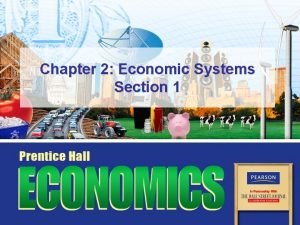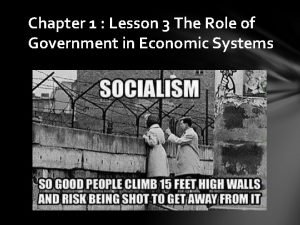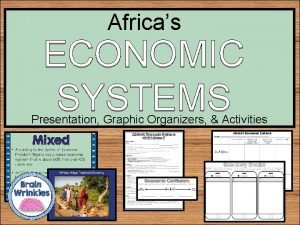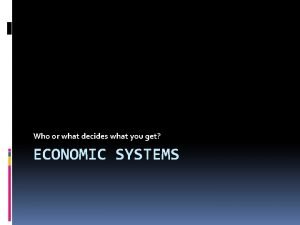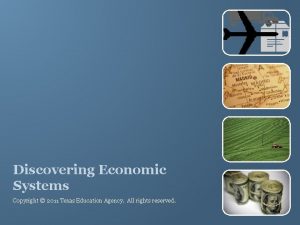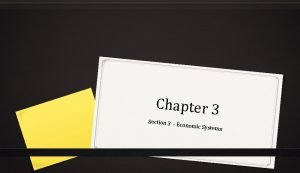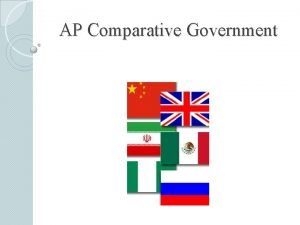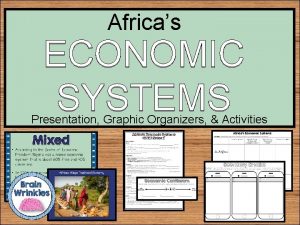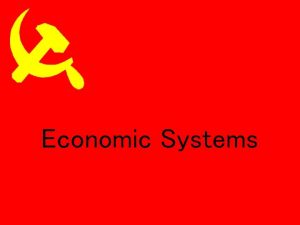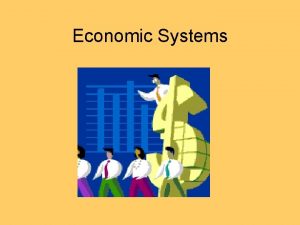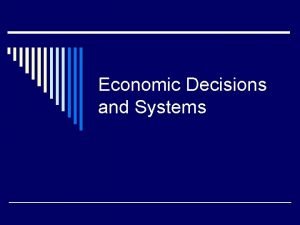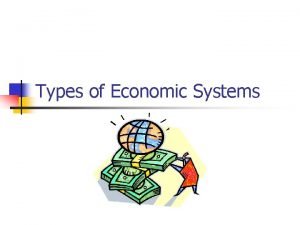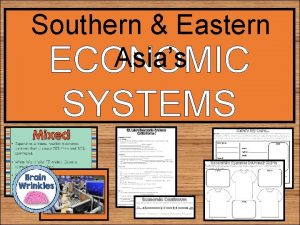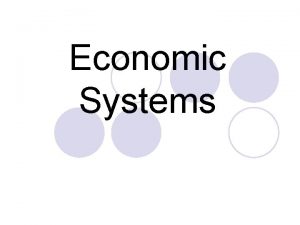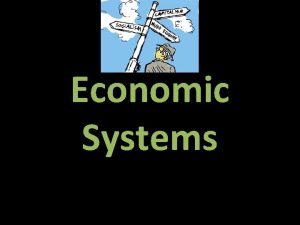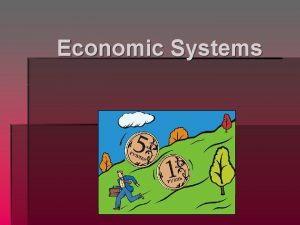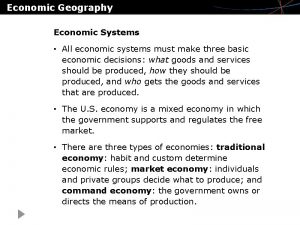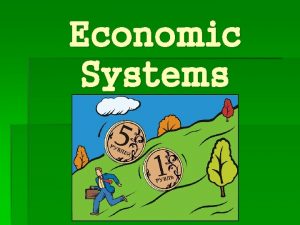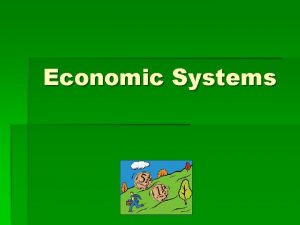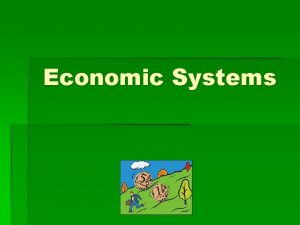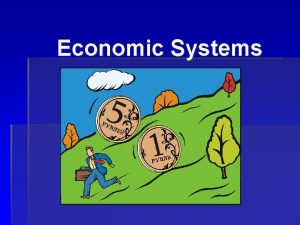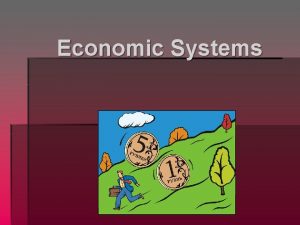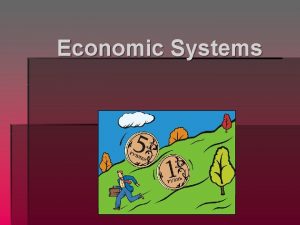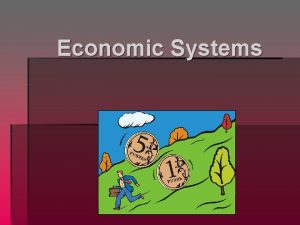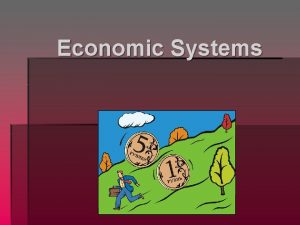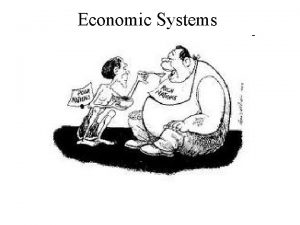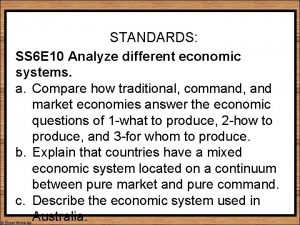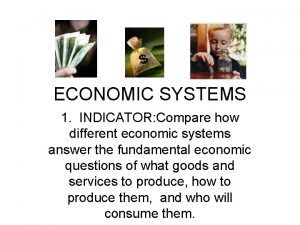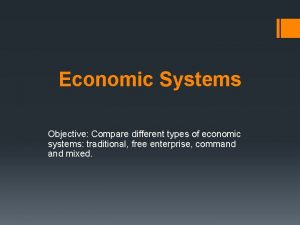SS 7 E 5 Analyze different economic systems



























- Slides: 27

SS 7 E 5 Analyze different economic systems. a. Compare how traditional, command, and market economies answer the economic questions of (1) what to produce, (2) how to produce, and (3) for whom to produce. b. Explain how most countries have a mixed economy located on a continuum between pure market and pure command. c. Compare and contrast the economic systems in Israel, Saudi Arabia, and Turkey.

Introduction to Economics: The study of how people satisfy their needs and wants. Economic system: a system that deals with the production, distribution and consumption of goods and services. Needs are things that a person has to have to survive. Examples: Food, Clothing, Water, Shelter. Wants are those things that you would like, but do not need to survive. Examples: TV, I-Pad, Concert Tickets etc.

Scarcity: A limited amount of resources to meet unlimited wants and needs. EVERYTHING is scarce! We have unlimited wants and needs but limited resources which creates SCARCITY so we need to make CHOICES: 3 Economics Questions 1. What to produce? 2. How to Produce? 3. For Whom to produce? Economist classify economies into 3 main systems: Traditional, Command Market.

Traditional Economy • In a traditional economy what to produce is determined by traditions and habits based on basic needs. • Often these decisions about how to produce are based on customs such as hunting, fishing, gathering, and farming etc. • In a traditional economy the question of whom to produce is based on what the society needs to survive. • There NO PURE TRADITIONAL economies around. • Examples of Traditional Economies in history are the Native Americans and Amish societies.

Command Economy • In a command economy the government makes all the decisions so what to produce, how to produce and for whom to produce are all determined by the government. • Governments in a command economy are usually led by a dictator and/or are totalitarian governments. • In an command economy the government owns the major industries(businesses). • Because of this the government controls the quantity (amount) of goods produced and their prices and how much people get paid.

Command Economy • Examples of command economies in history: – The Soviet Union under Joseph Stalin. – China under Mao Zedong – Cuba under Fidel Castro THERE ARE NO PURE COMMAND economies today beside North Korea.

Market Economy • In a market economy businesses make decisions based on consumer demands. • What to produce: consumers based on demand(needs/wants) and supply(make goods/services). • How to produce: determined by industries using the factors of production(land, labor and factories/machines). • For whom to produce: Supply and demand determines the price of goods. • In a pure market, there is NO government involvement. • In a market economy businesses are owned by individuals, entrepreneurs, and private businesses. • Examples of market economies in history: – England/Great Britain during the Industrial Revolution. – The U. S. during the Industrial Revolution. THERE ARE NO PURE MARKET economies around

Mixed Economy • In a mixed economy decisions are made by business based on consumer demands. • However, the government also makes some decisions: – Regulates trade – Ensures safety of consumers – Protects the environment. • Businesses produce goods based on consumer’s demands. • Supply and demand determines the price of goods. • In a market economy businesses are owned by individuals, entrepreneurs, and private businesses. • Majority of today’s nations are MIXED.



SS 7 E 5. c Compare and contrast the economic systems in Israel, Saudi Arabia, Turkey, and Iran

Israel • No natural resources or arable farmland compared to its oil rich neighbors. • Economy based on advanced technology, financial services and hi-tech agriculture. • Government controls military, police and key infrastructure such as the airport and other public sector services. • Majority of the businesses in Israel are owned by entrepreneurs who employ majority of Israeli citizens making Israel a mostly mixed economy.

Saudi Arabia • Largest economy I the Middle East • Rich oil reserves but this portion of the economy is heavily regulate by the government. • Profit from oil allows them to buy most goods they are unable to produce themselves such as food, weapons etc. • Although the King and his advisors make most decisions about how and where to spend the oil profits, a good chunk of Saudi Arabia’s economy is controlled by private entrepreneurs.

Iran 2 nd largest economy in the Middle East. Great oil and natural gas wealth but the economy is under heavy control by the government. Command economy has not been efficient in recent times. Recently, Iran is shifting to a more mixed economy due to attempts to allow some private involvement in the economy. Despite the oil wealth, the Iranian people do not share in the money.

Turkey • The government of Iran controls about 62% of the businesses in Turkey such as airlines, railroads, telephone, and the state television station. • Recently the gov’t has loosened its hold on these industries and allowed some private ownership. • More laws have been passed to protect business owners.

SS 7 E 6 The student will explain how voluntary trade benefits buyers and sellers in Southwest Asia (Middle East). a. Explain how specialization encourages trade between countries. b. Compare and contrast different types of trade barriers, such as tariffs, quotas, and embargos. c. Explain the primary function of the Organization of Petroleum Exporting Countries (OPEC). d. Explain why international trade requires a system for exchanging currencies between

A. Explain how specialization encourages trade between countries • Specialization: It occurs when a country concentrates on making few products better than other countries so they can trade and make a profit. • Every country cannot produce all the goods and services it needs. • Countries specialize in producing those goods and services that they can provide most efficiently(easy, better and cheap).

• They use the profits from the sales to buy the things that they need. • Saudi Arabia specializes in oil while Israel specializes in agricultural technology.


B. Compare and contrast different types of trade barriers such as tariffs, quotas, and embargos. • Trade barriers are anything that slows down or prevent one country from exchanging goods with another country. • There are two types of trade barriers: protective and punitive/political barriers.

PROTECTIVE BARRIERS • Tariff: a tax placed on goods when they are imported into one country from another to make the imported item more expensive than a similar item made locally. Why? • Protects local manufacturers from competition coming from cheaper goods made in other countries.

PROTECTIVE BARRIERS • Quota- limits the amounts of foreign goods that can come into a country. Why ? • A quota ensures that citizens buy locally made products.

PUNITIVE/POLITICAL BARRIERS • Embargo- A ban on trade with another country. • It is done due to political disputes between two countries or to punish a country. • Can hurt both countries.

C. Explain the primary function of the Organization of Petroleum Exporting Countries (OPEC) • They decide how much oil to produce and sell and they decide the price of a barrel of oil. • When they produce less, the price goes up. When they produce more, the price goes down.

ECONOMIC QUIZ 1. What is economic specialization? 2. In what product does Saudi Arabia specialize? 3. What does Israel specialize in producing? 4. What are the purposes of trade barriers? 5. What is a tariff? 6. What is a quota? 7. What is an embargo? 8. Name 2 protective trade barriers. 9. What is the purpose of an embargo? 10. Why was OPEC created? 11. What happens to the price of oil when OPEC decides to limit oil production?

1. What is economic specialization? It occurs when a country concentrates on making few products better than other and trading with others for what they also need. 2. In what product does Saudi Arabia specialize? Oil 3. What does Israel specialize in producing? Agricultural technology 4. What are the purposes of trade barriers? Trade barriers are put in place to either protect local businesses or punish another country. 5. What is a tariff? It’s a tax on imported goods. 6. What is a quota? It is a limit on the amount of goods that can be imported into a country

7. What is an embargo? It’s a ban or stop on trade with another country 8. Name 2 protective trade measures. The two protective barriers are tariff and quota. 9. What is the purpose of an embargo? The purpose of an embargo is to punish a country due to political differences 10. Why was OPEC created? OPEC was created by oil rich countries to control the production and sale of oil around the world 11. What happens to the price of oil when OPEC decides to limit oil production? The price will likely go up.
 Chapter 1 lesson 2 our economic choices worksheet answers
Chapter 1 lesson 2 our economic choices worksheet answers What are the different kinds of economic systems
What are the different kinds of economic systems Economic growth vs economic development
Economic growth vs economic development Difference between economic growth and economic development
Difference between economic growth and economic development Types of economic integration pdf
Types of economic integration pdf Being resourceful meaning
Being resourceful meaning Economic systems examples
Economic systems examples Command economy examples
Command economy examples How many economic systems are there
How many economic systems are there Chapter 2 economic systems and decision making answer key
Chapter 2 economic systems and decision making answer key Traditional economy political cartoon
Traditional economy political cartoon Chapter 2 economic systems answer key
Chapter 2 economic systems answer key Chapter 2 economic systems and decision making
Chapter 2 economic systems and decision making Chapter 2 economic resources and systems
Chapter 2 economic resources and systems Lesson 3 the role of government in economic systems
Lesson 3 the role of government in economic systems Africa's economic systems comprehension check answer key
Africa's economic systems comprehension check answer key Economic systems
Economic systems Free enterprise and other economic systems
Free enterprise and other economic systems Discovering economic systems comparative worksheet answers
Discovering economic systems comparative worksheet answers The three economic systems
The three economic systems Economic systems
Economic systems Africa's economic systems cloze notes 1
Africa's economic systems cloze notes 1 Chapter 2 economic systems and decision making answer key
Chapter 2 economic systems and decision making answer key Traditional economy strengths and weaknesses
Traditional economy strengths and weaknesses Command economy example
Command economy example Chapter 1 economic decisions and systems answer key
Chapter 1 economic decisions and systems answer key Command economy
Command economy Se asian economies comprehension check answer key
Se asian economies comprehension check answer key

